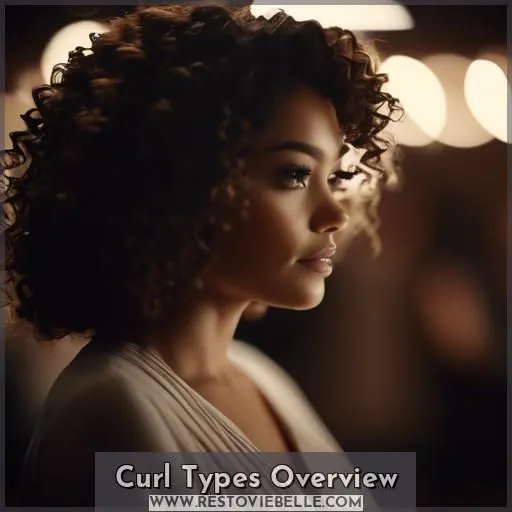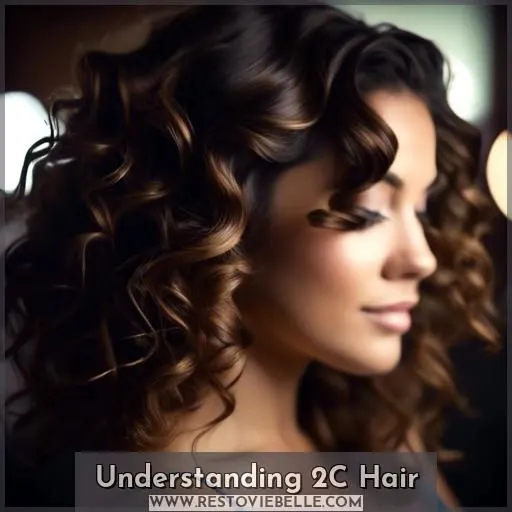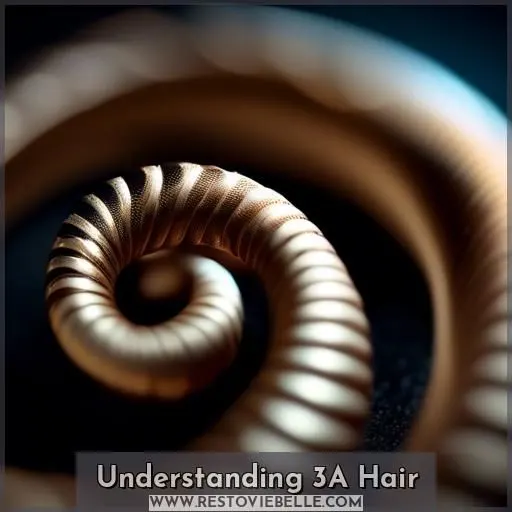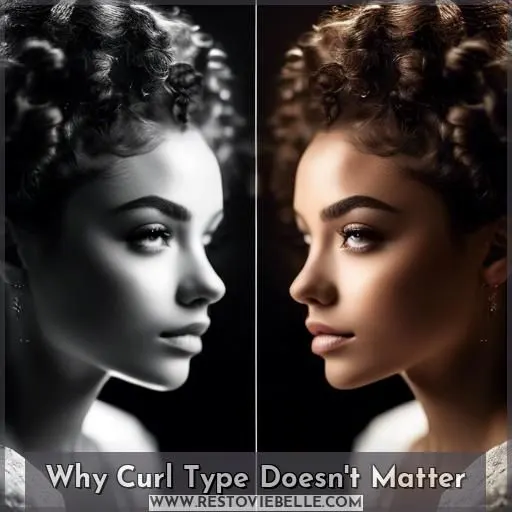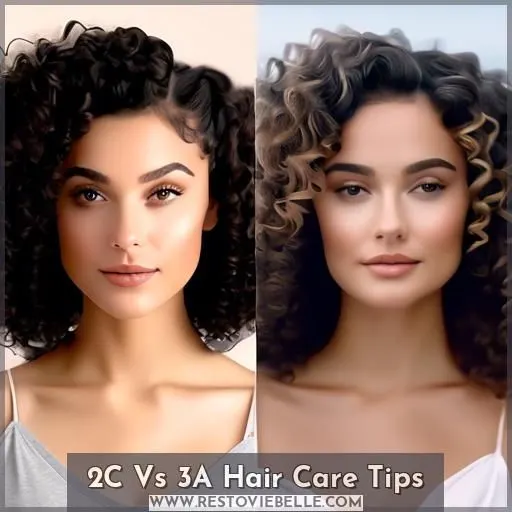This site is supported by our readers. We may earn a commission, at no cost to you, if you purchase through links.
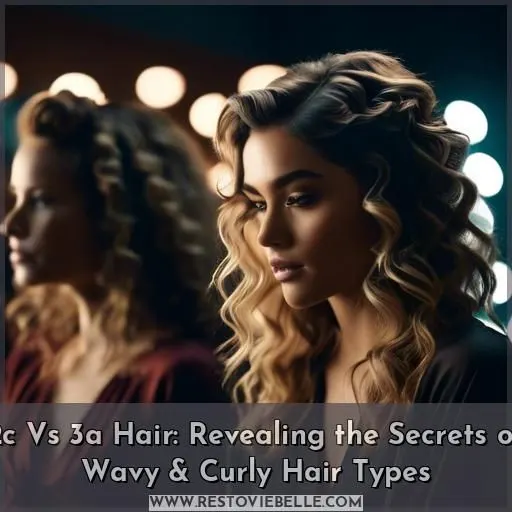
As you explore the curl spectrum, the wavy 2C hair and the spiraled 3A curls each possess their own distinctive appeal. 2C hair flaunts pronounced waves with an S-shape beginning at the roots, susceptible to frizz and oiliness, but with a voluminous texture.
In contrast, 3A hair exhibits relaxed yet defined spirals, necessitating delicate styling methods to preserve its full-bodied movement. While curl type is intriguing, comprehending your hair’s porosity is more pivotal in determining product compatibility.
Delve deeper into the subtleties of 2C and 3A hair care, from detangling techniques to styling secrets, to unveil the true potential of your wavy or curly tresses.
Table Of Contents
Key Takeaways
- Understanding your hair’s porosity is more important than curl type in determining product compatibility.
- 2C hair, also known as wavy hair, is characterized by an S-shape that starts at the root and may spiral towards the ends, and is susceptible to frizz and oiliness.
- 3A hair, also known as curly hair, exhibits relaxed yet defined spirals and requires gentle styling methods to preserve its full-bodied movement.
- To care for 2C hair, it’s important to maintain moisture and prevent frizz, while for 3A hair, it’s important to avoid harsh products and opt for gentle styling methods.
Curl Types Overview
Are you curious about the different curl types? From the slight waves of Type 2 hair to the tight coils of Type 4, understanding your curl pattern can help you better care for your tresses.
Type 2 Wavy Hair
Type 2C hair, also known as wavy hair, is the waviest pattern within the type 2 category. It’s characterized by an S shape that starts right at the root and may even spiral some on the ends. This hair type often experiences frizz due to the bends throughout, which prevent each strand from lying smooth and flat. However, it’s possible to achieve defined waves with styling techniques like scrunching and when using gels. 2C hair may get oily in between washes and may struggle with volume at the roots.
2C hair can be compared to type 2B hair, which also has an S shape but starts forming at the midpoints of the hair. Type 2B hair has a medium level of thickness and voluminous texture, allowing it to easily retain its shape even when wet but also making it more prone to frizziness. 2C hair, on the other hand, has a higher density and coarser texture, which can lead to a higher level of shrinkage when wet.
To care for 2C hair, it’s important to maintain moisture and prevent frizz. This can be achieved through the use of lightweight styling products and techniques that help enhance and define the natural wave pattern. Regular trims every 6-8 weeks can also help maintain the health and shape of the waves. At night, using a satin or silk pillowcase can reduce friction that can lead to frizz and tangles.
Type 3 Curly Hair
As we explore the realm of curly hair, it’s time to discover Type 3 Curly Hair. This hair type, also known as 3A, features relaxed curls with distinct spirals. To maintain healthy and lustrous 3A curls, avoid using harsh products and opt for gentle styling methods. Here are some tips:
- Products: Select lightweight, hydrating products to prevent weighing down your curls.
- Detangling: Always use a wide-tooth comb on damp hair to avoid breakage.
- Styling: Apply a small amount of gel on soaking wet hair and scrunch-pulse upside down and side to side.
- Drying: Allow your hair to dry naturally or use a microfiber towel/t-shirt to reduce frizz.
- Maintenance: Refresh curls on day 2-5 with a curling spray or water, and use dry shampoo on days when you’re not washing your hair.
Type 4 Coily Hair
Imagine your coily hair texture as a labyrinth of lively spirals, each ringlet a symbol of your distinctive style. Taming this mane necessitates a gentle touch—consider hydrating shampoo to quench its thirst and a microfiber towel to caress each curl.
Detangling coily knots? A breeze with silk or satin scrunchies. Steer clear of harsh chemicals, and indulge your locks in a nourishing hair mask for a crowning glory that’s exclusively yours.
Understanding 2C Hair
If you have 2C hair, you’re likely blessed with defined waves and spirals that flow from your roots. While these luscious locks may be a dream, they can also come with their fair share of common concerns requiring extra TLC.
Defining 2C Waves and Spirals
2C hair is a distinctive fusion of waves and curls, marked by its distinct S-shaped waves and delicate curls that originate from the root. It occupies the middle ground between wavy and curly hair types, striking a harmonious balance between the two.
2C hair boasts a coarser texture compared to its 2A and 2B counterparts, but it inherently exhibits a voluminous body, lending it a more full-bodied appearance. Its texture is dense and voluminous, rendering it susceptible to frizz, tangles, and dryness.
Grasping the nuances of 2C hair is paramount for discerning the most suitable products and care regimen.
Common Concerns for 2C Hair
2C Hair: Common Concerns
If you’re dealing with 2C hair, you might be familiar with these common concerns:
- Dryness: Our natural curls can be prone to dryness due to oil distribution.
- Frizz: Humidity and damage can cause unwanted frizziness.
- Tangles: The spiral structure of our curls can lead to tangles and knots.
- Lack of nourishment: Scalp oils may not reach the ends of our curls, leading to a need for extra nourishment.
To address these concerns, consider the following tips:
- Conditioner: Use a conditioner specifically formulated for curly hair to provide moisture and definition.
- Gel: Apply a quarter-sized amount of gel on each side of your hair and another quarter for scrunching.
- Raking Method: Apply the gel using the raking method on soaking wet hair.
- Detangling: Use a wide-tooth comb to detangle your hair in the shower.
- Products: Look for products with moisturizing ingredients, such as shea moisture, to keep your curls hydrated.
Understanding 3A Hair
Do you have type 3A hair? This curl type is characterized by loose, defined spirals with full body and movement. Understanding the unique traits and common concerns of 3A hair can help you better care for your luscious locks.
Characteristics of 3A Curls
3A curls are springy, bouncy, and defined, with a diameter similar to chalk. They have loose curls with defined spirals, full body, and movement.
To keep your 3A curls hydrated, use a moisturizing shampoo and conditioner. Detangle with a wide-tooth comb on wet hair, and avoid brushing dry curls.
For styling, apply a quarter-sized amount of curl definer and use the raking method on soaking wet hair. Air-dry or use a diffuser on low heat, and avoid heat tools without protection.
Use a leave-in conditioner for continuous moisture, and consider a weekly hair mask for extra hydration.
Common Concerns for 3A Hair
As a curly-haired individual, you might be familiar with the struggles of dealing with dryness, frizz, tangles, and knots. These are common concerns for 3A hair, which has a chalky diameter, loose curls with defined spirals, and full body and movement. To address these issues, it’s imperative to adopt a hair care routine that focuses on hydration, gentle handling, and the right hair products. Here are some tips to help you manage your 3A curls:
- Hydration: Use a moisturizing shampoo and conditioner to prevent dryness and frizz. Consider a weekly hair mask for extra hydration.
- Detangling: Use a wide-tooth comb on wet hair to avoid breakage. In the shower, use your fingers or a wide-tooth comb to detangle your curls.
- Heat-Free Styling: Air dry or use a diffuser on low heat to minimize damage. Avoid brushing dry curls and use a microfiber towel or t-shirt to dry your hair gently.
- Products: Look for hair products that provide moisture and definition, such as a curl definer, shine enhancer, and hairspray. Opt for heat-free styling tools and avoid harsh chemicals that can damage your hair.
Why Curl Type Doesn’t Matter
You may believe your curl type is vital, but it’s actually not that significant. Instead, it’s your hair’s porosity that determines the true distinction regarding which products are best suited for your strands.
Hair Porosity Importance
Hair porosity plays an essential role in the health and appearance of your curls. Understanding your hair’s porosity can help you make smart decisions about the products you use and the care you provide. Here’s a quick guide to hair porosity and its importance:
Hair porosity refers to the hair’s ability to absorb and retain moisture. It’s determined by the structure of the hair cuticle, which is the outermost layer of the hair shaft. Low porosity hair has tightly bound cuticle layers, making it difficult for moisture to penetrate and escape. High porosity hair has gaps and openings in the cuticle layer, allowing moisture to easily pass in and out.
Understanding your hair porosity can help you choose the right products for your hair. For example, low porosity hair may benefit from lighter products that don’t weigh down the curls, while high porosity hair may need more moisturizing products to combat frizz and dryness.
Here’s a simple table to illustrate the relationship between hair porosity and product selection:
| Hair Porosity | Product Selection |
|---|---|
| Low | Lightweight, non-greasy products |
| Medium | Balanced products that provide moisture and definition |
| High | Moisturizing, hydrating products |
Multiple Curl Types on One Head
Just as you wouldn’t wear the same outfit to a ballgame and a ballroom, your hair’s mixed curl types call for a diverse styling playbook. Embrace the curl type diversity on your head; it’s like a party where every curl brings its own dance move. Here’s a quick guide to harmonize your hair’s melody:
- Celebrate different curl patterns with targeted styling techniques.
- Use a wide-tooth comb for detangling without drama.
- Avoid blow drying on high heat to keep the peace among your strands.
- Choose not your mother’s products that cater to curl type variations, because one size doesn’t fit all.
2C Vs 3A Hair Care Tips
Whether you have type 2C wavy or type 3A curly hair, your detangling and hydration routine is key. From gel application and styling to drying and maintaining your waves or curls, the right techniques can make all the difference.
Detangling and Hydration
Regarding the care of your 2C or 3A hair, detangling and hydration are paramount aspects that can significantly impact its health and appearance. These techniques, in conjunction with appropriate product choices, can optimize results for your specific curl type.
Detangling:
- Wide-tooth comb: Employ a wide-tooth comb on damp hair to detangle curls without inducing breakage or harm.
- Fingers: For tighter 3A curls, gently detangle with your fingers, commencing from the ends and progressing towards the roots.
- Shower: Detangle your hair in the shower, as the conditioner and water facilitate easier disentanglement.
Hydration:
- Moisturizing shampoo: Select a moisturizing shampoo that mitigates dryness and frizz.
- Conditioner: Utilize a moisturizing conditioner, particularly on days you don’t wash your hair, to maintain hydration and manageability.
- Deep conditioning: Regular deep conditioning, especially for 3A hair, is vital for preserving hair health and combating dryness.
Product Recommendations:
- Lightweight Ouidad products: For 2C hair, opt for lightweight Ouidad products to prevent weighing down curls.
- Moisturizing conditioner: Seek out conditioners containing moisturizing components to maintain hydration.
- Leave-in conditioner: Apply a leave-in conditioner to provide ongoing moisture and protect hair from heat and other forms of damage.
Hair Porosity:
Understanding your hair’s porosity is essential for selecting the most effective products and care regimen. High porosity hair readily absorbs moisture but loses it quickly, while low porosity hair resists moisture absorption. Medium porosity hair strikes the optimal balance in moisture retention and requires the least amount of maintenance.
Gel Application and Styling
//controlledchaoshair.com/blogs/curly-hair-news/how-to-care-for-2c-hair
How to Care for 2c Hair? Tips, Products, and Hair Care Routine
2023
Drying and Maintenance
Drying and maintaining your curls is essential for keeping them healthy and looking their best. For 2C and 3A hair, air drying or using a microfiber towel or t-shirt is advisable to avoid frizz. Scrunching intermittently as your hair dries helps to shape the curls.
At night, use a high, loose ponytail with a silk or satin scrunchie for delicate care.
Day 2-5 Hair Care
Keep your curls alive between washes with these easy tips. For days when you’re not washing, flip your hair upside down to refresh curls with curling spray or water. Dry shampoo is your friend on non-wash days, extending the time between washes.
Don’t forget to wash your hair once a week, and on non-wash days, use a hair extension or hair accessory to add a pop of color or texture.
Frequently Asked Questions (FAQs)
How does climate affect 2C and 3A hair?
Did you know that hair can absorb up to 30% of its weight in moisture? So if you live in a humid climate, your 2C and 3A curls’ll thrive, but dry air’ll leave ’em feeling parched and frizzy.
Can diet influence the texture of curly hair?
Your diet plays a big role in the health and texture of your curly locks. Load up on omega-3s, vitamin C, and protein to nourish those spirals from the inside out. You’ll notice a bounce-back in no time!
What are the best haircuts for 2C/3A hair?
Classy cuts complement curly configurations, crafting eye-catching canvases. Consider cascading layers, curtained cuts, or choppy chops – these styles showcase stunning spirals. Suit your style, slay your strands, and savour the splendour of your singular ‘do.
How to transition from heat-damaged to natural curls?
Start small – trimming heat-damaged ends, deep conditioning weekly, and gently coaxing your natural curl pattern back. Be patient, your curls’ll bounce back with tender, loving care. You’ve got this!
Are there any specific vitamins beneficial for curly hair?
Hair, like a garden, thrives when nourished. Curl-friendly vitamins, like C and E, are your green thumb – they’ll coax out your hair’s vibrant potential. Nourish your locks, and watch your curls flourish.
Conclusion
Ultimately, whether you’re rocking 2C waves or 3A curls, understanding your hair’s unique needs is key. From detangling to styling, harness the power of porosity-based products to bring out the best in your wavy or curly tresses.
Experiment with specific 2C and 3A hair care techniques to reveal the true beauty of your locks. After all, the 2C vs 3A hair journey is all about celebrating your natural texture and enhancing its radiance.

